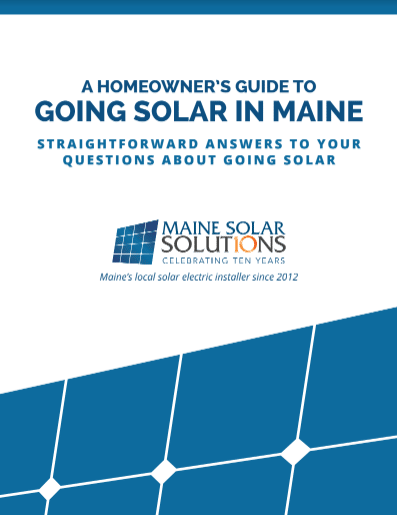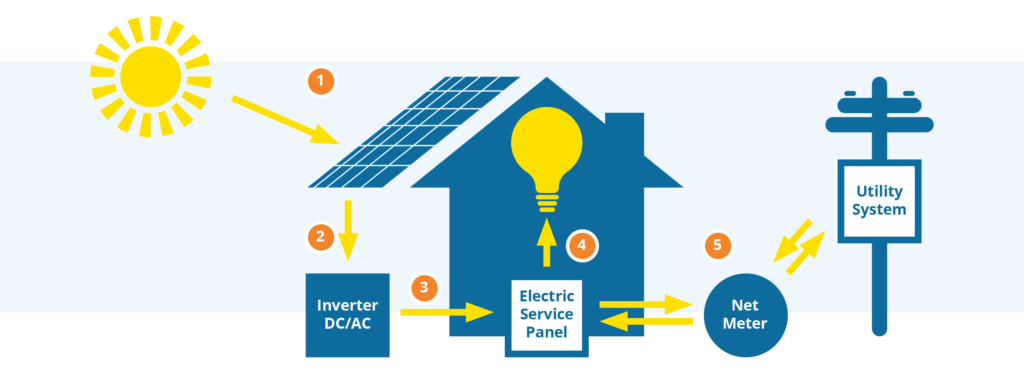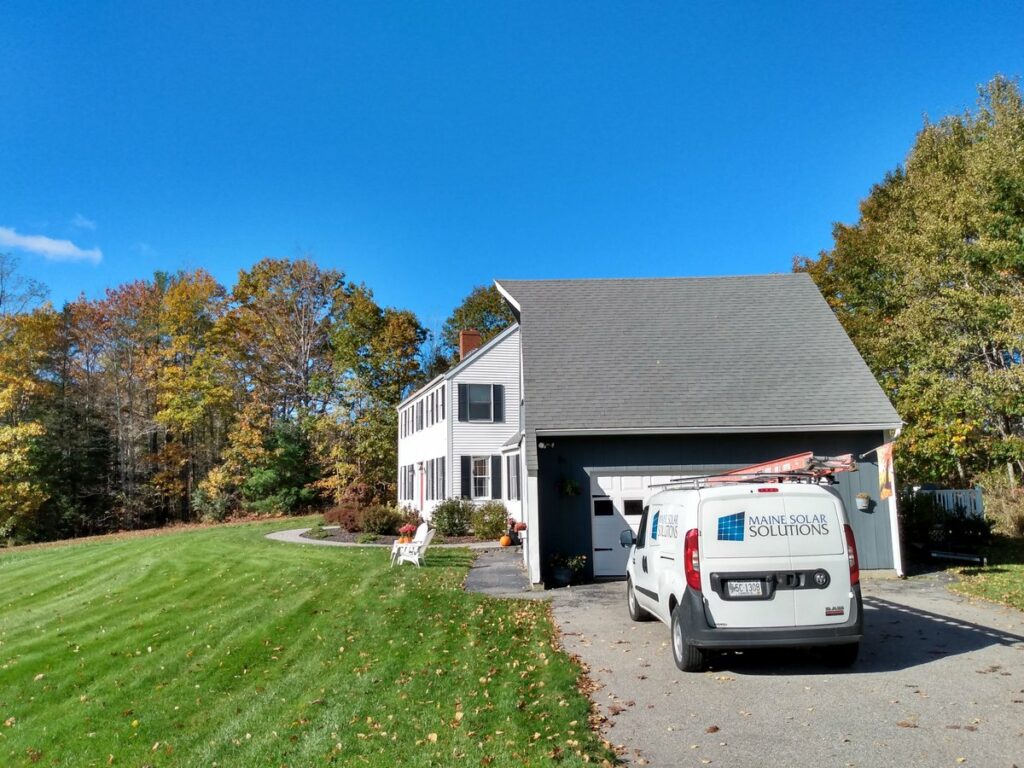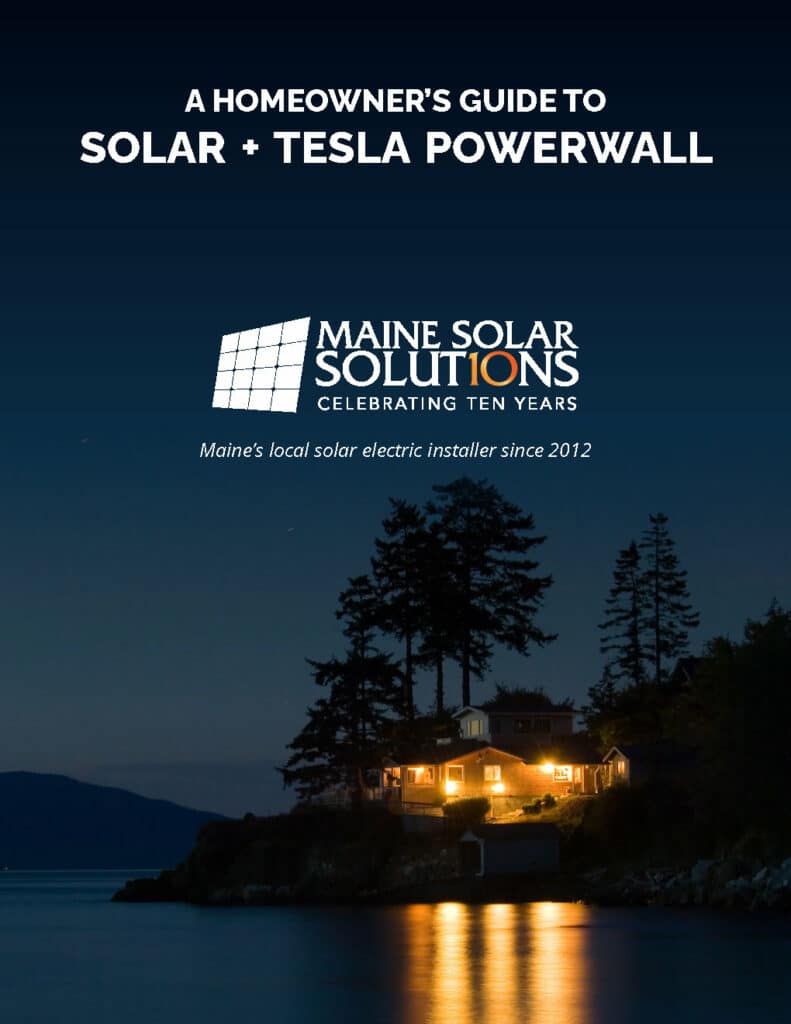There is a lot to learn when making the decision to invest in a renewable energy system for your home or business. Our goal is to guide you through the process of determining if a renewable energy system makes sense for you. We offer a consultative approach focusing on communicating clearly and providing the information you need to make an informed decision.
To help guide you on your solar journey, we listed answers to our most frequently asked questions below. As you review, please do not hesitate to contact our team directly if more questions arise.
The Homeowner’s Guide To Going Solar In Maine

Download your free eBook!
This free resource is packed with answers to the most common questions we receive about solar energy installations in Maine.
Frequently Asked Questions
Solar Cost, Savings, And Ways To Pay
What is the average cost of solar in Maine? Will it help me save money? Do you provide financing?
Your system’s cost is determined by factors such as current electrical usage, the percentage of your usage that you wish to offset, equipment choices, and your budget. We will gather information during your free site evaluation and, if appropriate, present a couple of different options.
The average home in Maine uses between 8,000 kWh and 12,000 kWh of electricity per year. The cost for a grid-tied, rooftop solar electric system designed to cover this electricity usage would have a direct purchase price between $24,162 and $29,697. Once the 30% tax credit is factored in, the net purchase price would range between $16,913 and $20,788. Pricing estimates assume an unshaded, south-facing roof with a 35-degree roof pitch. Production levels and costs will vary depending on your free site assessment findings.
For most homeowners, you can see a payback or return on investment (ROI) in as few as 7 to 10 years. Your solar array protects you from rising electrical rates immediately; as those increase each year, your ROI only improves. Check out our Solar Pricing page for a deeper dive into solar pricing.
Your annual electric bill will go down. How much you save will depend on the size of your system and the percentage of your electrical usage that you wish to offset. Your solar consultant will review your savings during your free consultation so you can make a decision that makes financial sense for you.
Buyers see the benefits of buying a home that can generate its own electricity, so installing solar panels can help you sell your home faster and likely at a significantly higher price. In a study by Lawrence Berkeley Labs, homebuyers were willing to pay a premium of $15,000 more for a home with an average-sized solar system.
Maine Solar Solutions offer loans through Mosaic. Many of our clients also finance their systems with home equity loans or with home refinancing. Here, you can learn more about financing options or ways to pay for solar panels in Maine.
Solar is cleaner and less expensive than power from the utility company. It is a smart financial investment because you will save on electrical costs for years to come and increase your home value.
Our customers who purchase their system typically see a strong return on investment (ROI) and expect to recoup their solar system investment within 7-12 years. After the system has paid for itself, it continues to pay by providing free electricity.
As electrical utility rates rise, your solar investment becomes even more valuable, and your property’s value also increases!
How Does Solar Work?
Does Maine get enough sun for solar? What is net metering? This section gives an overview of how solar works.
Yes, Maine receives enough sun to make solar PV effective and affordable. Germany is the world leader in solar installations; Maine receives nearly 20% more sunlight annually than Germany.

- Solar panels convert energy from the sun into Direct Current (DC) electricity.
- That DC electricity travels to an inverter where it is converted into the Alternating Current (AC) electricity used in your home.
- The inverter delivers the AC electricity to your electrical panel, where it is distributed to electrical loads throughout your home.
- Your home uses the solar produced electricity but still has access to electricity from the grid during high demand or at night.we gatheredytime when your system is producing power, any electrical demands in your home are satisfied by the electricity that you produce first.
If your home’s demand is greater than the amount of electricity being produced on the roof (such as during the evening or inclement weather), the electric utility, or grid, will provide the rest.
On the other hand, if your system’s electrical production is greater than your home’s electrical demand, the excess power is sent out on the grid, building upcredit .
At the end of your billing period, your electric provider will subtract the energy you put out on the grid from the energy that you imported from the grid and charge you for the difference. This is called net metering.
Net metering is a purchasing agreement between you and the electric utility (Central Maine Power (CMP), for example) that allows you to receive credit for excess energy that your solar array may produce.
Net metering is a simple concept; power created from your solar system is connected to the electric grid and credited in real-time. Any excess power created by the solar system that you are not using, at that moment, is fed back into the power grid.
As this excess power is ‘back-fed’, your meter operates in reverse. CMP subtracts the excess kW hours that you produce from the kW hours that you get from the grid and only charges for only the “net” electricity that you receive from the grid.
Typically, energy credits that are built up during the day are “traded in” at night. Not only are credits built up and “cashed in” on a daily basis, but credits are accrued and credited on a rolling 12-month period, allowing greater summertime electricity production to offset greater wintertime use.
Types Of Solar Electric Systems
This section answers questions about what type of solar electric system will work best for you and where solar panels get placed.
Most of our customers install grid-tied PV systems. Grid-tied systems allow for seamless integration with your
Maine Solar Solutions offers grid-tied systems with battery backup and off-grid systems for clients who desire a battery backup system.
South-facing is best, but solar panels installed facing south-east or south-west can generate a very high percentage (>90%) of energy as compared to
During our site evaluation, we will determine how much of your roof is shaded throughout the year. We can factor this into your estimated electricity production.
We offer system designs that work effectively to provide maximum performance from partially shaded arrays.
We assess your roof’s condition as part of our site survey. A typical
Installing a PV array will shade the underlying roof, protecting it from damaging sunlight and weather, possibly extending the roof’s lifespan. If we determine that your roof needs replacement, we can refer you to a trusted roofing contractor.
No. There are other options, such as a ground mount or wall-mounted awning systems. Mounting on a garage, barn, or outbuilding is also an option.
Ground mounts are a good option if your roof is not properly oriented, if your roof is heavily shaded, or if you do not want to install solar panels on your roof.
With a ground mounted system, you may either have fixed panels or trackers, which move on two
At Maine Solar Solutions, our team of experts continually examines our product offering to ensure our customers are receiving the best all-around panels available on the market versus offering only one manufacturer choice at a time.
We select our solar panels based on several factors, such as the manufacturer’s reputation, product availability, quality history, and the company’s financial standing. View more about panel choices here.
Battery Backup and Solar
A grid-tied solar electric system will not provide backup power during a power outage. We offer battery systems for customers seeking to add a backup power source to their grid-tied solar electric system.
Most grid-tied systems are designed to shut off automatically during power outages when the grid goes down. When power returns, your system will restart automatically. For customers interested in investing in a battery-based PV system, we can design and install a grid-tied battery backup that will allow them to power certain electrical loads in your home during a power outage.
Grid-tied PV systems do not require batteries. Maine Solar Solutions does offer a grid-tied battery backup system, including Tesla Powerwalls, in addition to true off-grid systems, but for most customers, a grid-tied system with battery backup offers the best value and performance.
Maine Solar Solutions offers grid-tied systems with battery backup and off-grid systems for clients who are not connected to utility providers. We install both traditional
Maine Solar Solutions is proud to be certified to sell and install the Tesla Powerwall in Maine. We are also a Tesla Solar Panel Certified Installer in Maine.
Download Your Tesla Powerwall Guide Below!
This free resource is packed with answers to the most common questions we receive about Tesla Powerwall, including specs, how battery storage + solar work, costs, and more!
Our team continuously evaluates the best technology to offer the most reliable and cost-effective energy storage solutions. We tailor each solar battery solution for your home or business’s energy storage needs and offer a variety of batteries, including traditional lead-acid batteries and lithium-ion. The most popular option among our grid-tied solar customers is the lithium-ion-based Tesla Powerwall, but we also install Generac and Sol-Ark systems. Maine Solar Solutions is also the preferred installer for the Ford Lightning Vehicle-To-Home systems in Maine. Our solar consultants will discuss your options during your consultation.
We design a manual or automatic PV system shut-off for customers with generators based on your generator type.
System Sizing And Our Process
How do we determine your system size, and what happens at your free solar site assessment?
During our free site evaluation, we will work with you to determine what size system will meet your needs. Every home is different, so the size of your system will depend on your energy needs, available space, and budget.
Residential solar power systems are typically 3 to 10 kW. Based on the information we gathered during our site evaluation, we will custom design a solar power system to meet your specific needs and offset as much of your utility bill as you desire.
For a rooftop solar array, we will conduct an onsite assessment of your roof to determine its pitch and orientation and perform a thorough shade reading and roof measurement. We assess your outside electrical service and look at the potential panel layout and location of wire runs.
If a ground mount is desired or determined to be the best option, we will suggest array locations and educate you about fixed versus tracking solar arrays.
Information gathered at your home is used to design a system sized to offset your annual electricity usage. You can schedule your free solar site assessment here.
Solar systems are designed to offset your annual electricity usage. We review your latest electric bill and calculate your annual electricity consumption. Then we take into account potential changes to your future electricity usage. For example, many of our customers install heat pumps and heat-pump hot water heaters to reduce their use of expensive fossil fuels. Are you planning to purchase an electric vehicle? Considering a pool or hot tub? If so, it may make sense to design a system that allows for easy expansion if and when your usage increases.
When sizing a home’s solar system, we typically look at the homeowner’s historic electric bills to understand their energy needs. The information won’t be available for a new home, but we can still gather other details to estimate your energy consumption and appropriately size the solar system. During our intro call, we will discuss your desired electrical and mechanical systems and how solar might fit into the home’s design. We will also likely address any potential shading with a visit to your site.
Rebates And Incentives To Go Solar
Learn more about the federal solar tax credit and other benefits of solar energy.
Solar photovoltaic and battery backup systems qualify for a 30% federal tax credit until 2032. This credit is a dollar-for-dollar tax credit and will reduce the amount of tax owed by the system owner before any deductions are applied.
The tax credit then steps down according to the following schedule:
- 26 percent for solar and battery backup projects in 2033
- 22 percent for solar and battery backup projects in 2034
- After 2034, the federal solar tax credit is set to expire.
Yes! The Rural Energy for America Program, better known as the REAP Grant, provides grant funding to rural small businesses and agricultural producers across the United States to implement renewable energy system. To see if you qualify, visit our REAP Grant page.
Absolutely! Maine Solar Solutions recognizes the exceptional sacrifices and efforts of those who serve in our armed forces, and we wish to support local heroes for their service. This program is for veterans, active duty service members, and reserves who would like to purchase a solar energy system. We offer a $500 discount on a solar electric system (1-lifetime max per customer for each discount).
NOTE: This discount cannot be combined with any other offer. Current customers can utilize the discount within 60 days of their contract date. Please have identification available to verify your military status upon inquiry.
Maintenance and Warranties
The good news is that grid-tied solar electric systems require little maintenance during their
lifespan and have great warranties.
Most solar panels’ performance is guaranteed for 25 – 30 years, but panels will go on to produce electricity for longer. As they naturally degrade over time, or if you add more electricity to your home, such as installing heat pumps or an electric car, we can expand your system to cover the added electricity or degradation from your panels.
All of the solar panels we install have power output warrantied for 25+ years (at 85-92% of the original power output.) The lifespan of a PV array is expected to be greater than 30 years. Inverter warranties range between 10 and 25 years. During our solar assessment, we will review warranties so you can make the best decision for yourself
Our workmanship is the best in the industry, and our 10-year installation warranty reflects this.
The good news is that grid-tied solar electric
systems require little maintenance during their
lifespan to keep your solar system running.
Plus, if something goes wrong, there is a good
chance the warranty will cover it. You don’t even have to worry about cleaning your panels in most cases!
Our grid-tied installations also include system
monitoring, so you can watch the entire array
and each panel’s output information on your
desktop or your phone so that you can watch output information and alerts in case of a problem.
We recommend that our customers tell their homeowners insurance about their solar panels to cover them under their existing policy.
Installing Your Solar Electric System
The good news is that grid-tied solar electric systems require little maintenance during their
lifespan and have excellent warranties.
The actual installation is an exciting day and
surprisingly straightforward. Your Maine Solar
Solutions team will arrive and get right to work.
Some team members will work
on installing your new panels, and the others
will take care of all the grid and electrical
work. Though most of the work is performed
outside, we will need access to your electrical
panel to connect the solar system to your
home. After the team installs and connects
the new solar panels, the lead on your project
will show you your new system and answer
any questions.
No. We always use an industry-standard flashed attachment point with our installations, protecting the integrity of your roof and ensuring a waterproof connection.
Typical residential systems typically take 2 to 5 days to install. Ground mount systems and larger systems can take longer.
We usually schedule our installations on a first-come, first-served basis; however, installations can be scheduled for specific blocks of time. Needless to say, inclement weather may impact our installation schedule.

Ready For The Next Step?
Our process makes it simple to make the switch to solar. Your free consultation will include an onsite assessment, a customized system design with solar panel options, and a range of pricing to fit your energy goals and budget.

